
Prokaryotic and eukaryotic cells. Bacteria and archaea.
- Subject:
- Biology
- Life Science
- Material Type:
- Lesson
- Provider:
- Khan Academy
- Provider Set:
- Khan Academy
- Author:
- Sal Khan
- Date Added:
- 07/22/2015

Prokaryotic and eukaryotic cells. Bacteria and archaea.

In this subject, we consider two basic topics in cellular biophysics, posed here as questions:
Which molecules are transported across cellular membranes, and what are the mechanisms of transport? How do cells maintain their compositions, volume, and membrane potential?
How are potentials generated across the membranes of cells? What do these potentials do?
Although the questions posed are fundamentally biological questions, the methods for answering these questions are inherently multidisciplinary. As we will see throughout the course, the role of mathematical models is to express concepts precisely enough that precise conclusions can be drawn. In connection with all the topics covered, we will consider both theory and experiment. For the student, the educational value of examining the interplay between theory and experiment transcends the value of the specific knowledge gained in the subject matter.
This course is jointly offered through four departments, available to both undergraduates and graduates.

Size, Scales, and Specialization was developed as part of an effort by the Quantitative Biology at Community Colleges group to provide materials that incorporate mathematical concepts into biology courses. The activity uses published estimates of cell type numbers in the human body along with size, density and weight as a lens to have students calculate ratios, explore exponents, and better understand how the various cell types contribute to an average human's total weight and size. The activity is applicable for majors and non-majors biology courses, and maps to Chapter 4 of the OpenStax Biology 2e textbook. This activity could also be used in a mathematics course as a biologically relevant example.
The activity contains a pre-assessment to gauge student understanding of the material and provides an opportunity for students to predict the number of various cell types, as well as the mass of various cell types, in the human body. This prediction activity is followed with a guided approach to calculating these values. After guiding the students in this activity, students will then have a chance to practice the activity on a new set of cell data provided.
After completing this module students should be able to:
- Compare and contrast the structure and function of different cell types.
-- List the largest and the smallest cells in the body based on number.
-- List the largest and the smallest cells in the body based on mass.
- Describe the advantages of specialization in eukaryotic cells.
-- Give examples of how specialization in cell types affects cell size (volume) and shape.
- Perform measurements and conversions using the metric system.
-- Measure the scale of cell size variation in the human body
-- Calculate the relative proportions of cell types in the human body by mass and frequency

Thinking about how large a cell is compared to viruses, proteins and simple molecules.
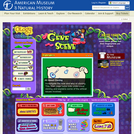
This fun Web site is part of OLogy, where kids can collect virtual trading cards and create projects with them. Here, they learn about the human genome project by clicking through an online slide show, hosted by kids, that answers these questions: What's a genome, anyway?What is the human genome project? What does it mean to me?
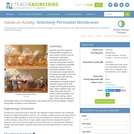
Students learn that engineers develop different polymers to serve various functions and are introduced to selectively permeable membranes. In a warm-up activity, they construct models of selectively permeable membranes using common household materials, and are reminded about simple diffusion and passive transport. In the main activity, student pairs test and compare the selective permeability of everyday polymer materials engineered for food storage (including plastic grocery bags, zipper sandwich bags, and plastic wrap) with various in-solution molecules (iodine, corn starch, food coloring, marker dye), assess how the polymer’s permeability relates to its function/purpose, and compare that to the permeability of dialysis tubing (which simulates a cell membrane).
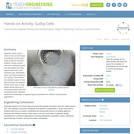
Students culture cells in order to find out which type of surfactant (in this case, soap) is best at removing bacteria. Groups culture cells from unwashed hands and add regular bar soap, regular liquid soap, anti-bacterial soap, dishwasher soap, and hand sanitizer to the cultures. The cultures are allowed to grow for two days and then the students assess which type of soap design did the best job of removing bacteria cells from unwashed hands. Students extend their knowledge of engineering and surfactants for different environmental applications.
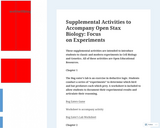
These supplemental activities are intended to introduce students to classic and modern experiments in Cell Biology and Genetics. All of these activities are Open Educational Resources.
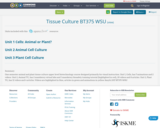
One semester animal and plant tissue culture upper level biotechnology course designed primarily for visual instruction. Unit 1, Cells, has 7 animations and 2 videos. Unit 2, Animal TC, has 2 mandatory virtual labs and 1 mandatory biosafety training tutorial (highlighted in red), 20 videos and 8 articles. Unit 3, Plant TC, has 12 videos and 4 articles. Videos are highlighted in blue, articles in green and animations in yellow.
Smyth 2017 BT375 WSU

Paul Andersen takes you on a tour of the cell. He starts by explaining the difference between prokaryotic and eukaryotic cells. He also explains why cells are small but not infinitely small. He also explains how the organelles work together in a similar fashion.
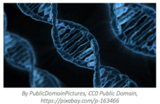
This seminar helps the learner explore the basic concepts of life and what that means. All life has certain things in common as well as a basic level of organization. In this seminar you will investigate these traits and why they are important to life.StandardsBIO.A.1.1.1 Describe the characteristics of life shared by all prokaryotic and eukaryotic organisms.

This laboratory manual is intended for use in a biology laboratory course taken by non-science majors, pre-biology, and pre-allied health majors.
Laboratory exercises provide students with experience in basic laboratory skills, gathering and organizing data, measuring and calculating, hypothesis testing, analysis of data, writing, and laboratory safety. The skill sets are designed to promote the development of critical thought and analysis. Students work with living and preserved specimens, and laboratory reagents and equipment.
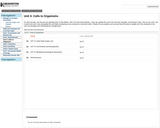
For this unit plan, see the old unit calendar (link on left sidebar, click ALT3 tab at the bottom). Once we update this unit to the new Doc template, we will post it here. This is now unit 3, but it used to be unit 2 (we will update file and folder numbering as we continue to revise the units). Thanks for your patience as we work hard this year to update all of the materials to the new unit template and unit/standards arrangements.
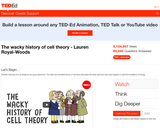
Scientific discovery isn't as simple as one good experiment. The weird and wonderful history of cell theory illuminates the twists and turns that came together to build the foundations of biology.

Contains tool overview and student example